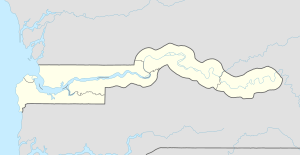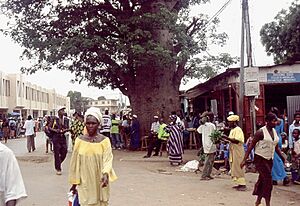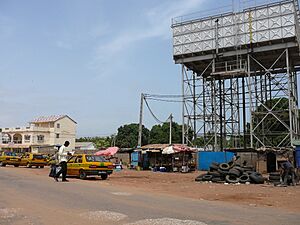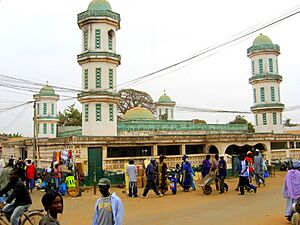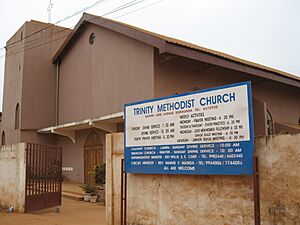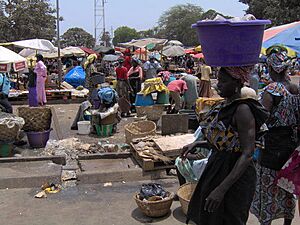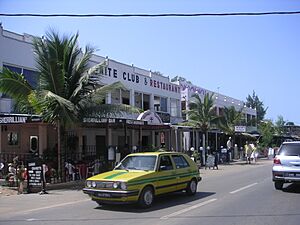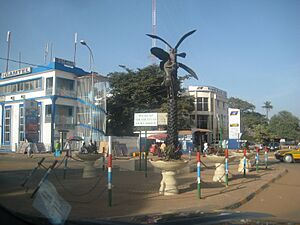Serekunda facts for kids
Quick facts for kids
Serekunda
|
|
|---|---|
|
City
|
|

Downtown Serekunda
|
|
| Country | Gambia |
| Division | Kanifing |
| District | Kanifing |
| Founded by | Sayerr Jobe |
| Named for | Founder |
| Population
(2013)
|
|
| • City | 19,944 |
| • Urban
(Kanifing Municipal Council)
|
382,096 |
| Time zone | 0 GMT |
Serekunda or Serrekunda is the biggest city in The Gambia. It is located near the Atlantic Ocean coast and the Gambia River. The capital city, Banjul, is also nearby. Serekunda and Banjul together form a large urban area called the Kombos. About half of The Gambia's people live in this area.
Serekunda got its name from Sayerr Jobe, who founded the city in the 1800s. It started as a few villages that grew together. Banjul is on a small island, so it couldn't grow much. This made Serekunda grow a lot, and many businesses moved there from Banjul. Serekunda has also been a place for political protests. Since the 1980s, it has been an important center for the Tablighi Jamaat religious movement.
Serekunda has the largest market in The Gambia. Near the coast, the Senegambia Strip is a popular spot for tourists. Gambian wrestling and football are very popular sports here.
Contents
History of Serekunda
How Serekunda Started
Serekunda was founded in the late 1800s by Sayerr Jobe. He was a Wolof man from a place called Koki in Senegal. Jobe's family was part of the royal class. He left Koki because of a power struggle. He traveled upriver to Niumi, then to Banjul, before settling in Serekunda. At that time, the area was mostly a thick forest. Sayerr Jobe passed on his power to his seven sons before he died in 1896.
The name 'Serekunda' comes from "Sayerr Jobe Kunda," which means "Sayerr Jobe's town." The street where his home was located is now called Sayerr Jobe Avenue. Over time, several small villages like Dippa Kunda, Latri Kunda, and Serekunda grew and merged to become the city we know today.
Serekunda's Growth and Changes
In the 1960s, Serekunda and Bakau grew as nearby towns to Bathurst (now Banjul). They formed what was known as a "Mandinka belt." Serekunda continued to expand because Banjul, being on a small island, had limited space to grow. This led to many people and businesses moving to Serekunda.
The city has seen various political changes over the years. People from different political groups have won seats representing Serekunda. In 1977, the Serekunda area for elections was divided into two parts.
In 2015, the local government renamed Sayerr Jobe Avenue after the mayor. This decision caused some debate. Sayerr Jobe's family and other residents felt it ignored his important history.
Recent Events in Serekunda
In December 2016, when the former president refused to accept election results, soldiers were sent to Banjul and Serekunda. Later, international forces arrived to help. Nigerian soldiers were deployed in Serekunda. When the former president left the country in January 2017, many people celebrated at Westfield Junction in Serekunda.
After the current president, Adama Barrow, won the 2021 election, some supporters of the losing candidate gathered at his house in Serekunda. They were dispersed, which led to criticism from human rights groups.
Where is Serekunda?
Serekunda and Banjul are about 18 kilometers (11 miles) apart. They are both on the coast of the Atlantic Ocean, near where the Gambia River meets the sea. The combined urban area of Serekunda and Banjul, called the Kombos, is the only major city area in The Gambia.
Banjul's growth has been limited because it's an island surrounded by mangrove swamps. This means Serekunda has taken in many people and businesses that couldn't fit in Banjul. In the 2000s, many offices moved from Banjul to Serekunda because it had more modern buildings and better services. Bakau, which used to be a fishing village, has also grown and become part of Serekunda's large urban area.
Serekunda's Weather
Serekunda is close to the Sahara Desert. The sky is clear and cloudless for about 80% of the year. It has one rainy season, which lasts from June to October.
People of Serekunda
| Historical population | ||
|---|---|---|
| Year | Pop. | ±% |
| 1993 | 18,901 | — |
| 2003 | 19,292 | +2.1% |
| 2013 | 19,944 | +3.4% |
How Many People Live Here?
In 2013, the city of Serekunda itself had 19,944 people. The larger area of Kanifing, which includes Serekunda, had a population of 382,096 people. This area is the only major urban center in The Gambia. As of 2018, about half of the country's population lives in the Kanifing and Serekunda urban area.
Languages Spoken
Serekunda is a very diverse city with many different ethnic groups and languages. The Wolof language is often used as a common language (a lingua franca) in Serekunda and in the western part of the country. Almost all signs are in Gambian English. Most residents speak either Wolof or Mandinka.
People Moving to Serekunda
Many people from villages move to the Kombos area to study, find jobs, start small businesses, or join relatives' businesses. On average, these people stay for about two years.
Serekunda is also home to groups of Soninke people, including many from the town of Sabi. Some Soninke families have moved to Serekunda. In the 1970s and 1980s, many wealthy Soninke people chose to move to the Kombos for business reasons.
After the Sierra Leonean Civil War, thousands of people from Sierra Leone lived in Serekunda and Bakau in 2003. Many of them had good education and looked for skilled jobs.
Religions in Serekunda
Islam in Serekunda
The Serrekunda Mosque is the oldest mosque in the area. It is located on Sayerr Jobe Avenue, across from where Sayerr Jobe's home used to be. Another important mosque is the Pipeline Mosque on Kairaba Avenue. It can hold 3,000 people and has a tall minaret.
Serekunda is a major center for the Tablighi Jamaat Islamic movement. Their main center, called the Markaz (which means "Center"), is in the Bundung area. It is open to the public and holds gatherings on Thursdays. People from all over West Africa come to the city for this movement.
Other Religions
Besides Islam, there are also churches in Serekunda, like the Trinity Methodist Church and Saint Therese's Catholic Church. The Baháʼí Faith also has a presence here, with a Spiritual Assembly established in Serekunda in 1954.
Serekunda's Economy
In 2013, the Kanifing area, which includes Serekunda, had the most businesses of any local government area in The Gambia. It had 14,924 businesses, which was over 40% of the country's total.
Serekunda Market
Serekunda Market is in the heart of the city. It is the largest market in The Gambia and is also known as Sandika. Traders have been selling goods here since the early 1800s. The market started with women selling fish and vegetables by a dirt road and has grown a lot since then.
The market sells many fresh vegetables and fish. It's also a popular place to buy batik fabrics. You can find other businesses nearby, including electronics repair shops. Vendors have sometimes said the market is too small. They have also complained about floods during the rainy season, which can make fewer people visit.
Trade and Business
People from nearby villages sometimes work in Serekunda during the week and farm on weekends. Some farmers also sell their produce at Serekunda Market.
Serekunda and other Gambian cities have informal trade networks. These networks sometimes move products across the border between The Gambia and Senegal. The Banjul-Serrekunda Highway has large billboards for companies. Sayerr Jobe Avenue has many shops that advertise to people walking or driving by.
Tourism in Serekunda
The Senegambia Strip is a short road with many restaurants and music places. It is the most popular spot in the country for entertainment near the beach. Tourists from wealthy countries visit here, and their spending helps the local economy a lot.
The Serekunda/Banjul area has twenty hotels where most tourists stay. Many tourists book their trips through tour operators. A beachfront area in Kololi has popular luxury hotels, like the Kairaba Hotel and the Senegambia Hotel.
City Services
Getting Around
The Banjul-Serekunda Highway is a four-lane road that connects Westfield to Banjul. It includes the Denton Bridge. Thousands of people use this highway to travel to work in Banjul. Serekunda is connected to Banjul by public buses and private taxis.
Westfield Junction is a very busy intersection where the highway to Banjul ends. From this junction, drivers can go to coastal Serekunda or further inland. Sayerr Jobe Avenue runs from Westfield to London Corner through central Serekunda. It is a busy shopping street with a lot of traffic.
Healthcare Services
Kanifing General Hospital, once called Serrekunda General Hospital, is a major hospital. It serves about 600,000 people. As of 2021, it has 114 beds and two operating rooms. It is the second-biggest trauma center in the country.
The Serekunda Health Centre serves about 123,000 people in Serekunda and nearby areas. It is one of the busiest health facilities in The Gambia. It helps deliver over 300 babies each month.
Internet and Radio
The Serekunda Internet Exchange Point has been working since July 2014. This exchange helps provide internet for a large part of West Africa. Radio 1 FM is an independent radio station that started in 1990.
Waste Management
Waste from Kanifing is taken to the Bakoteh Dump Site, which is on a main road to Serekunda. This is an open dump, and the only way they manage the waste is by burning it. This causes air, soil, and water pollution. It also leads to health problems and bad smells. A new program started in 2022 plans to add more rubbish bins and change the Bakoteh Dump Site into a transfer station.
Waste comes from homes and Serekunda Market. In 2017, market vendors complained about people dumping trash in the market. This caused pest problems and made people not want to shop there.
Sports in Serekunda
Wrestling
Gambian wrestling became very popular in Serekunda. The B.O. Semega Janneh arena in Dippa Kunda is a famous wrestling venue. Semega Promotion holds matches between local wrestlers at the Serekunda West Mini Stadium. Serekunda Mbolo is a team in the Gambia Wrestling Association. Wrestling matches are popular with foreign tourists.
Football
The Gambia Football Federation improved two stadiums in Serekunda for the country to host the 2005 African U-17 Championship. The Gambia National Olympic Committee also completed a mini stadium in Serekunda in 2001. The Serekunda East and Serekunda West football stadiums were renovated in 2018.
Football clubs like Serrekunda United and Latrikunda United play in the GFA League Second Division.
See also
 In Spanish: Serekunda para niños
In Spanish: Serekunda para niños


